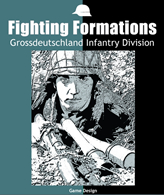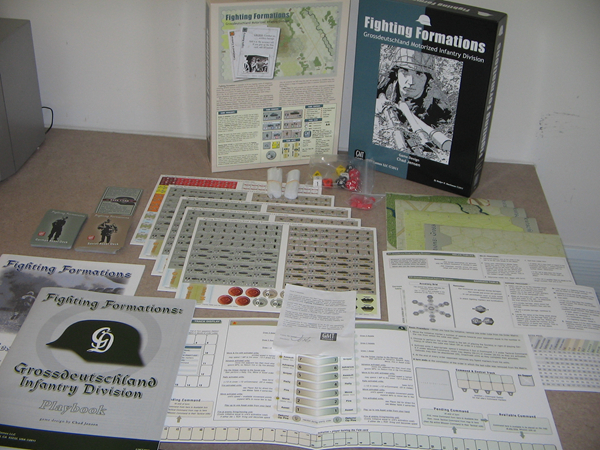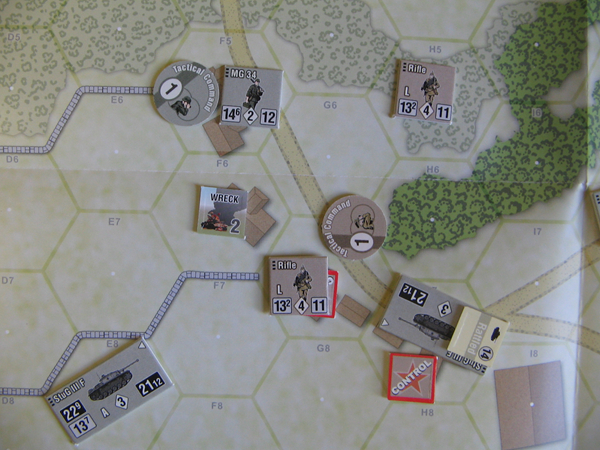Fighting Formations: Grossdeutschland Motorized Infantry Division – Board Game Review
 Fighting Formations: Grossdeutschland Motorized Infantry Division. Boardgame Review. Publisher: GMT Games: Designer: Chad Jensen. $55.00
Fighting Formations: Grossdeutschland Motorized Infantry Division. Boardgame Review. Publisher: GMT Games: Designer: Chad Jensen. $55.00
Passed Inspection: Well-written manual with a complete index and tons of examples. Pleasant looking map and components. Unique gameplay elements. Lots of background material – very well researched.
Failed Basic: Turn system is unique and takes some ramping up to get the feel for it. Covers only 10 months in the campaigns of the Division. No solitaire rules.
Last year, a number of the World War II games I reviewed for Armchair General were based upon D-Day and the Normandy Campaigns. Now in late 2010 and early 2011, a large number of excellent games have been released focusing on the Russian Front. This newest release from GMT games is no exception.
{default}GMT Games is an innovative game company whose games cover the gamut of history, from the Crusades to Revolutionary War ship to ship combat to World War II. Featuring professional and functional (but not always state of the art) maps and counters, their games are modern but with a late 1980s feel. This, in and of itself, is not necessarily a bad thing. Combined with GMT’s own unique twists on the tried and true war game formula, and their willingness to break with that tradition, each new GMT game provides something to savor.

Going back to the 80’s can be a good thing – these retro counters look great.
Fighting Formations is a new line of World War II games from GMT. Each release will focus on the combat history of a particular unit. The first in this exciting line is Fighting Formations: Grossdeutschland Motorized Infantry Division. Other subjects to come out in this series are the Africa Corp and Patton’s 3rd Armored Division.
Fighting Formations: Grossdeutschland Motorized Infantry Division is a tactical war game in which each counter represents a platoon or a squad (for infantry) or an individual tank, halftrack, medium machine gun and such. Each hex is 75 meters and each turn represents five minutes.
Upon opening the box, the player finds a basic rule book plus a book specifically detailing the featured formation, cards called “Asset Cards” plus one “Fate Card,” four double sided 22” x 34” maps, five handsome die cut counter sheets, three player aid sheets, 10 dice of a type any role-player would feel comfortable with (10-sided, 20-sided, etc.) and some little wooden cubes and a pawn such as you would find in a chess game. GMT has also thoughtfully included zip lock plastic storage bags for the components.

The game is loaded with tons of goodies.
Fighting Formations: Grossdeutschland Motorized Infantry Division’s counters are traditional side views featuring attractive pictures of the squads, platoons, tanks, guns, etc. along with the units size (squad or individual in the case of vehicles), armor piercing firepower, high explosive firepower, rate of fire, movement allowance and movement type (foot, wheel, tracks) and Armor/Moral ratings. Each unit also may have a rating for special actions, for example: the Panzer IV F2 can fire special rare APCR armor piercing ammo; prior to 1944, many Russian tanks had no radios, so their crew had to rely on formation tactics or watch for flags waving from the turret of the platoon leader; half-tracks are rated for being able to limber and unlimber guns as well as carry troops.
Terrain effects on combat as well as movement are well and completely covered and an attractive play chart provides easy access for the player. Air attacks as well as artillery is simply and elegantly covered on one table!

Asset cards provide random events which the players may find helpful – from air attacks to smoke screens, a great many locations of the World War II Russian Front are simulated. Another card is the “Fate Card.” The “Fate Card” allows the player who holds it to force a re-roll of an action or claim the initiative or even win the game in the case of a tie. But, when the “Fate Card” is used, it is immediately given to the other player. This delicate teeter-totter between the players is even more pronounced in the amazing initiative system devised by GMT.
The heart of the system is the Track Display and Order Matrix. This playing chart includes a turn display with a full turn sequence cheat sheet, boxes for command points, an Order Matrix and an Initiative Track. The Initiative Track is divided between a Russian Side and a German Side with a zero in the middle. The scenario will tell the player where to start the initiative. The Order Matrix is truly an amazingly innovative game concept – each side is rated for various commands – everything from Opportunity Fire, Moving, Firing, Rallying, Assaults, and Battalion through Divisional Support.
Each action is rated from 1 to 10. The ten little wooden cubes help keep track of actions performed each turn. The more advanced the action, the higher the number. Divisional Support (which allows the player to draw multiple Asset Cards) costs much more than simply ordering a platoon to attack an entrenched anti-tank gun. The little wooden pawn (the Initiative Marker) is placed over a number on the Initiative Track. As the players take actions, each action moves the Initiative Marker the number of the action towards the opposing player’s track. Therefore, a turn is not made up of one person waiting while the other player watches, each player must keep up with the action or suffer the consequences. It is this system of initiative, which truly adds uniqueness to the game.

The Germans surround a Soviet unit.
Each attack or defense is based upon a die roll (usually two d10) added to the counter’s rating. Based upon some specific actions (Opportunity Fire for example), the player may be required to roll two d8 or even two d6. Some actions give the unit a bonus and the player may be able to roll two d12 or even two d20, such as the time I tried to rally a Russian tank whose crew was shocked. The tank was in cover so instead of rolling two d10, I was able to roll two d12. The crew made the rally attempt easily and steadied themselves for a devastating shot that destroyed a Panzer III moving towards their flank.
The maps are nicely finished and should somewhat resist stains and usage wear. They feature a nice mix of rural and urban environments. The counters are sturdy and double sided.
The rules are comprehensive but are not what I would call an easy study. It took several test plays before I felt comfortable enough to say I understood many of the rules. Fortunately, there are plenty of well-illustrated examples to ease the player into the game. The index is complete—which is a breath of fresh air, as too many game writers don’t seem to know the meaning of the word. The scenarios are in chronological order and provide the history of the encounter as told in narratives by the men who were there.

Well-illustrated examples.
I love the use of dice normally associated with role playing games to be effectively used in a wargame. It’s nice to see the two hobbies fused in this way. Another nice fusion is GMT’s decision to put the game on the Vassal System. All the maps, counters, and charts are downloadable for virtual play, which greatly helps the learning curve.
The game box is handsome and nicely informative but I don’t know if the imagery will stand out on the shelf of a gaming store. The artwork of the game is handsome as well but I doubt it will grab the casual or neophyte wargamer. While other games look flashy, Fighting Formations: Grossdeutschland Infantry Division looks like a 1980s game. I find that attractive but will the all-important new generation of wargamers?
There are also no solitaire rules included. Perhaps the system is not conducive to the solitaire experience but I believe that an easy system could be worked out and should have been included.
The game only covers 10 months in the history of the Grossdeutschland Division but the unit pick is incredibly accurate down to the model 250 halftracks which they had to use until the larger 251 was issued to them. This level of detail is also reflected in the Division’s history and order of battle, which is also thoughtfully included.
All in all, Fighting Formations: Grossdeutschland Motorized Infantry Division, is a wonderful game whose small flaws should not keep the gaming public from discovering its intricacies.
Armchair General Rating: 93 %
Solitaire Rating: 2
About the Author
A college film instructor and small business owner, Richard Martin has also worked in the legal and real estate professions, is involved in video production, film criticism, sports shooting and is an avid World War I and II gamer who can remember war games which came in plastic bags and cost $2.99 (he’s really that old)!


Still not understanding the decision to use side art for the AFVs rather than top down, particularly if facing is important, but perhaps a minor quibble. Also fairly transparent is the fact that the game is researched heavily from Spaeter’s divisional histories – which are well known to anyone who has been a hobbyist interested in the GD, be he a reenactor, wargamer, uniform collector, etc. The drawback of that, of course, is that you get no perspective on the Soviet side of things other than through a German lens. Not a deal-breaker and perhaps not even necessary for a game, but as pointed out in the article – this is not a solitaire endeavour. So it makes it hard to get enthusiastic about playing the “faceless” bad guy, even if rudimentary unit identifications are given. The opponent is there mainly as set dressing. Really an odd proposition for a non-solitaire game to go forward from.
The article also doesn’t stress the controversy in the community about the selection of this most German of all German units for the premiere of the fighting formations series. I have no particular hardship with it myself (I run a website on the history of the PzGren Div GD for what it is worth) but the selection does seem odd when taken in the context I just mentioned.
Otherwise, a reasonable review of the game, though one wonders how many more tactical level board game systems we really need to have, given the existence of Valor & Victory, ASL, Panzergrenadier, the revival of PanzerBlitz in a series, ATS, Conflict of Heroes, etc.
I’m part of the new generation mentioned, and this review has certainly piquet my interest. The initiative track is a game mechanic I’m familiar with: it is found in a relatively new game from fantasyflight called Horus Heresy. It would be very amusing if GMT latched on to this mechanic from another company that routinely ripps off other people’s ideas. The only GMT game I presently own is command and colours ancients and in truth it is a bit bland.
I would seriously consider this game if it is a lot better.
Great wargame! Its system adds great replayability and realism to the flow of play! Very good game!